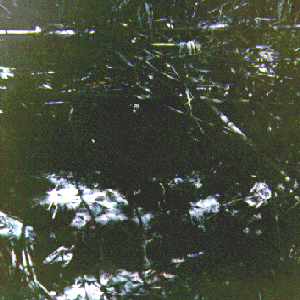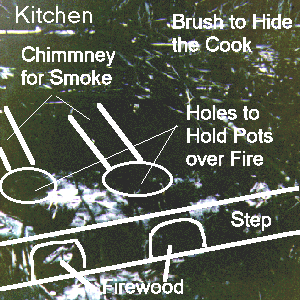July 14,1969 |
||||
|---|---|---|---|---|
|
We had found the trail early in the morning and decided to see where it would take us. It was more than
an animal trail, almost a meter wide and well trampled. The ground was hard but every wet spot we would
look for signs of :
We tried to walk on the edge of the trail to avoid leaving the distinctive American jungle boot track on the trail for anyone that might follow behind us. As the trail went into a steep incline I found myself using the convenient hand rail to pull myself up. As I climbed it dawned on me that hand rails were normally not associated with nature. As I looked closer it was obvious that the long vine had been carefully engineered to assist users of the trail. The point man froze and said "Bunker" . I looked where he pointed and saw the structure. We knelt an went into a defensive position. I turned and looked back down the hill and I could see we had already walked passed two other bunkers. Had the complex been occupied we would have already been in the midst of our enemy. We started exploring the bunker complex and I was fascinated by how the enemy must live. The bunkers were made by digging a T shaped hole in the ground. The cross of the T would be covered with logs and dirt. Each bunker was strategically placed so they could not be seen from the air.
It was obvious that the complex had been used, but not recently. Paper and trash that had been left behind was partially buried from the rains. Insects and animals had time to clean out any scraps that might have been left in a food can. It was also obvious that the latrine had not been used in a while. As the day went on we felt at ease exploring the enemy camp. I found where they had eaten an American canned ham. I also found a box which had contained playing cards with instructions in English. As the day wore down we decided it was time to start preparing for night. We moved back down the trail and found a wall of bamboo along the trail. We left the trail and went behind the bamboo and felt it would be the perfect place for the night. It was:
With at least a half an hour of daylight left, we moved to the night location and dropped our packs. We hung the poncho cover in the bamboo overhang. One of my men set a small ball of plastic explosive on fire to warm up some water for hot cocoa before dark and I decided to place my claymore mine next to the trail. I put the claymore mine under my armpit and started walking backwards toward the trail as I unraveled the wire that went between the mine an detonator. I?m not sure if I heard the words or just felt them "Sarge . . . Dinks" . I dropped to my knees and froze. Out of my left eye, I could see a column of men walking toward me. Not on the trail a few feet away, but in the jungle next to the trail with me. Out of my right eye, I could see my men. Two were watching the NVA soldiers and the third was hiding the small fire with his body. The poncho was green , but at his moment it looked more like a neon sign saying "Look here". I felt totally naked as I realized I had not even carried my rifle with me to place the mine. I started calculating at what point would I give away my location by breaking and running for my rifle. We were clearly out numbered and there was little comfort in knowing that we could probably kill eight to ten of them before they could kill four of us. The point man was less than thirty feet from me, when he suddenly turned and started walking down the hill toward the stream. The whole column followed, as more than 20 soldiers filed pass me. They were all carrying extremely large packs. Several of the soldiers had their rifles strapped to their packs. They looked tired and most of them seemed to only be watching for their next step. When the last soldier moved out of sight I ran back to the night location and got on the radio. I started directing artillery in the direction they were headed. Within minutes, gun ships were sent to support me. The helicopter pilots ask me to pop smoke so they would know my location. I refused in fear that smoke might also give my location away to the enemy if they were still near by. I offered to fire a pen flare that could be seen in the air. I fired the flare and the gun ship acknowledged seeing the flare and knowing my location. The four of us took defensive positions as we worried that the artillery and gun ships would scare the soldiers back to our location. The gun ships shot up everything within a mile of us in the direction we had last seen the soldiers. On one pass the gun ship fired it?s minguns just above us. When the casings from the rounds fell from the helicopter into the bamboo overhang we thought we were dead. Darkness covered us during this action. We were told that unless we were in direct danger they would prefer not to attempt a night extraction. No one slept that night, we set up all night listening for groaning or moaning of some injured soldier. Thankfully we didn?t hear a thing. If they survived, I?m sure it was a sleepless night for them, also. At first light, we got our gear and started moving toward an extraction point that was in the opposite direction of the NVA soldiers. We were extracted by helicopters and told that we would be replaced with an infantry platoon that would sweep the area. I was never told the results of the sweep.
|
||||
 Story INDEX
Story INDEX
|
 NEXT Story
NEXT Story
|
|---|
Web Page Created 12 Jan 1998
© 1997 C. Warren Gallion
eMail: wgal.gvn@gmail.com


